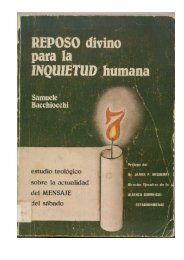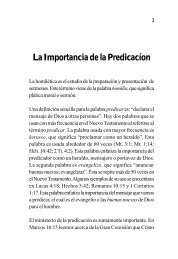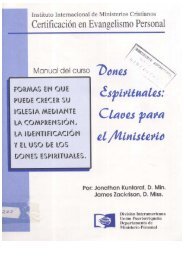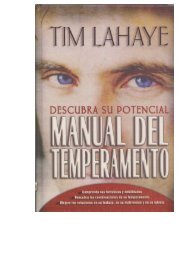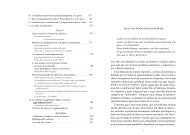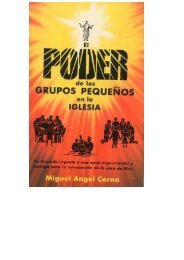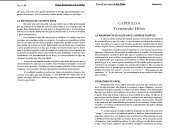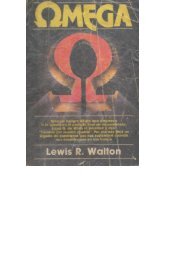Recapitulation in Revelation 4-11 - Ptr. Arturo Quintero
Recapitulation in Revelation 4-11 - Ptr. Arturo Quintero
Recapitulation in Revelation 4-11 - Ptr. Arturo Quintero
- No tags were found...
Create successful ePaper yourself
Turn your PDF publications into a flip-book with our unique Google optimized e-Paper software.
Appendix: The End of the Trumpet SeptetThe seven trumpets start with Rev 8:7. Each trumpet is clearly identified. The last trumpet beg<strong>in</strong>s withRev <strong>11</strong>: 15. The question, however, is where the trumpets end. Several suggestions, sometimes related,have been made:(1) Many scholars take Rev 2:19 as the end po<strong>in</strong>t of the trumpet vision or as the end of the first part ofthe Book of <strong>Revelation</strong>. This option does not necessarily exclude the view that the seventh trumpet <strong>in</strong>cludesother parts or the rest of <strong>Revelation</strong>. 43(2) Some suggest Rev <strong>11</strong>:18 as the end po<strong>in</strong>t of the trumpet septet. Consequently, Rev <strong>11</strong>:19 is the<strong>in</strong>troductory scene to a new cycle whose ma<strong>in</strong> part starts with 12:1. 44(3) Others propose that Rev <strong>11</strong>:19 at the same time closes one vision and opens another one. 45(4) F<strong>in</strong>ally, the suggestion is made that the seventh trumpet extends from Rev <strong>11</strong>:15 to Rev 13:184 46or even further. 47In any case, there is almost general agreement that someth<strong>in</strong>g new starts with Rev 12. A woman anda dragon are <strong>in</strong>troduced <strong>in</strong> Rev 12. In Rev 13, the dragon empowers a beast from the sea. Then a beast fromthe earth arises and <strong>in</strong>stigates the <strong>in</strong>habitants of the earth to establish an image of the beast. The dragon andthe beasts belong together and form a counter-tr<strong>in</strong>ity .The woman is opposed to that tr<strong>in</strong>ity. Clearly, this is43 See, for example, Coll<strong>in</strong>s, The Combat Myth, 26, 36, who takes Rev <strong>11</strong>:19 as the end po<strong>in</strong>t of the material associatedwith the scroll of Rev 5; Desmond Ford, Crisis! A Commentary onthe Book of <strong>Revelation</strong>, 3 vols. (Newcastle, CA: DesmondFord Pub, 1982), 2:504, 548; Wayne Richard Kempson, “Theology <strong>in</strong> the <strong>Revelation</strong> of John” (Ph.D. dissertation, SouthernBaptist Theological Sem<strong>in</strong>ary, 1982),<strong>11</strong>9, 123,140; and Richard C. Lenski, The Interpretation of St. John’s <strong>Revelation</strong>(M<strong>in</strong>neapolis: Augsburg, 1963), 357-358. Isbon T. Beckwith, The Apocalypse of John: Studies <strong>in</strong> Introduction with a Criticaland Exegetical Commentary (Grand Rapids: Baker, 1967), 6<strong>11</strong>, states: “The two parts of v. 19 correspond then with the twoparts of v. 18. . . . This verse is often taken as <strong>in</strong>troductory to chapt. 12; but its connection with that scene, which forms a newand quite dist<strong>in</strong>ct vision, is much less immediate than with the preced<strong>in</strong>g.” Roloff, 103-104, 138-140, states on p. 139: “A largecaesura lies between <strong>11</strong>:19 and 12:1. . . . In <strong>11</strong>:19, the first part of the visions has reached its end. . . . This series of visionsbeg<strong>in</strong>n<strong>in</strong>g with 12:1 is not a cont<strong>in</strong>uation, but a complementary supplement of everyth<strong>in</strong>g heretofore. John makes a freshbeg<strong>in</strong>n<strong>in</strong>g to portray the end event from a different perspective.” See also Barbara Wootten Snyder, “Combat Myth <strong>in</strong> theApocalypse: The Liturgy of the Day of the Lord and the Dedication of the Heavenly Temple” (Ph.D. dissertation, University ofCalifornia at Berkeley, 1991), 97. James Valent<strong>in</strong>e, “Theological Aspects of the Temple Motif <strong>in</strong> the Old Testament and<strong>Revelation</strong>” (Ph.D. dissertation, Boston University, 1985), declares on pp. 265-266: “Rev. <strong>11</strong>:19 is the climax of all of chs.1-<strong>11</strong>, but especially of chs. 4-5. . . . Just as <strong>in</strong> 4:1ff, the author is able to see the throne through the open door <strong>in</strong> the heavenlytemple, so <strong>in</strong> <strong>11</strong>:19 the temple <strong>in</strong> heaven is opened and the ark of the covenant is seen. . . . A new prophecy beg<strong>in</strong>s at 12:1.” Onp. 270, he remarks: “Rev. <strong>11</strong>:19 forms an <strong>in</strong>clusion with 4: 1ff, br<strong>in</strong>g<strong>in</strong>g to a climactic end the first half of the book.” See further,Robert W. Wall, <strong>Revelation</strong>, New International Biblical Commentary, vol. 18 (Peabody, MA: Hendrickson, 1991), 155.44 See, for example, Alfred Loisy. L ‘Apocalypse de Jean (Frankfurt: M<strong>in</strong>erva. 1972). 221; C. Mervyn Maxwell. GodCares, vol. 2 (Boise. ID: Pacific Press. 1985). 58-61, 309-310; Paul S. M<strong>in</strong>ear. I Saw a New Earth: An Introduction to theVisions of the Apocalypse (Wash<strong>in</strong>gton, DC: Corpus. 1968), 96-97,105,<strong>11</strong>4, <strong>11</strong>7; Strand, “The Eight Basic Visions.” <strong>11</strong>4; JohnF. Walvoord. The <strong>Revelation</strong> of Jesus Christ: A Commentary. (Chicago: Moody, 1966). 186; Wendland. 378, 380; and MichaelWilcock. The Message of <strong>Revelation</strong>: I Saw Heaven Opened. The Bible Speaks Today (Leicester: Inter-Varsity, 1975). <strong>11</strong>0.45 See. for example. M. Robert Mulholland, <strong>Revelation</strong>: Holy Liv<strong>in</strong>g <strong>in</strong> an Unholy World (Grand Rapids: Francis AsburyP of Zondervan. 1990).2<strong>11</strong>, 214. Henry Alford, The Greek Testament: with a Critically Revised Text: a Digest of VariousRead<strong>in</strong>gs: Marg<strong>in</strong>al References to Verbal and Idiomatic Usage: Prolegomena: and a Critical and Exegetical Commentary. Forthe Use of Theological Students and M<strong>in</strong>isters. In Four Volumes. Vol. IV. Part II. Conta<strong>in</strong><strong>in</strong>g the Epistles of St. John and St.Jude, and the <strong>Revelation</strong>, 3d ed. (London: Riv<strong>in</strong>gstons, 1866), 666, calls it “conclud<strong>in</strong>g and transitional.”46 See Hahn, 154. Charlier, 1:204-205, 256-257, takes this decision, but <strong>in</strong> his op<strong>in</strong>ion, “la septième trompette <strong>in</strong>troduitquatre séquences” (256). The first consists of Rev <strong>11</strong>:15-12:12 and has the follow<strong>in</strong>g elements:A Liturgy (<strong>11</strong>:15-18)B Vision (<strong>11</strong>:19-12:9)A’Liturgy (12:10-12).47 See the discussion on the third woe <strong>in</strong> E. Müller, 383-385.Page <strong>11</strong>




